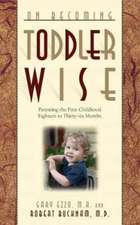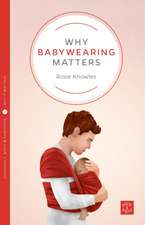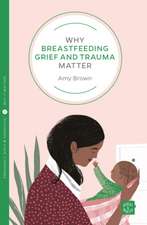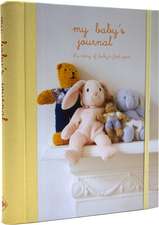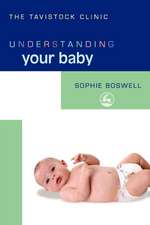Diaper-Free Before 3: The Healthier Way to Toilet Train and Help Your Child Out of Diapers Sooner
Autor Jill Lekovicen Limba Engleză Paperback – 31 mar 2006
Preț: 95.29 lei
Nou
Puncte Express: 143
Preț estimativ în valută:
18.23€ • 19.50$ • 15.20£
18.23€ • 19.50$ • 15.20£
Carte disponibilă
Livrare economică 27 martie-10 aprilie
Preluare comenzi: 021 569.72.76
Specificații
ISBN-13: 9780307237095
ISBN-10: 0307237095
Pagini: 223
Dimensiuni: 134 x 204 x 13 mm
Greutate: 0.2 kg
Editura: Three Rivers Press (CA)
ISBN-10: 0307237095
Pagini: 223
Dimensiuni: 134 x 204 x 13 mm
Greutate: 0.2 kg
Editura: Three Rivers Press (CA)
Extras
Chapter 1
What's wrong with the idea of readiness?
The parents of a healthy one-year-old boy, Jake, bring him in for his regular checkup. His growth is normal and his parents report that he started taking a few steps on his own over the last few weeks. He says "mommy" and "daddy," shakes his head no and yes, and looks around for his shoes or favorite toys when they are mentioned. He was weaned from the breast two months ago and now only takes a bottle before bed and nap. He loves a variety of foods and does well drinking from a cup.
Jake wears disposable diapers, and his parents have noticed that his diaper is often dry after a nap and that his bowel movements are usually after breakfast and dinner. He is curious about the toilet and wants to go in with his parents. He loves to have his diaper off and even tries to take it off himself at times. Jake's paternal grandmother got him a little potty chair for his first birthday, and his parents have a lot of concerns about when to introduce it. Their friends have told them that it is "way too early to even think about it." They want to know how to tell if he is ready to be toilet trained, and how to avoid making any mistakes along the way.
Is Jake ready to be toilet trained? Most doctors and parenting books recommend that children must show signs of readiness before beginning toilet training. Different experts list various skills, but most suggest that children require some communication skills, a desire to use the potty, and the ability to walk to the potty before being trained. Before you decide when it is best to start training your child, you should know that these guidelines (and the very idea of readiness) are based on the well-publicized opinions of a few individuals (not medical research), and are by no means infallible.
When you look at the history of potty training, how it was done in the past and under different circumstances, and how we came to consider the readiness guidelines to be the standard, you will begin to question what you have been told and to seriously reconsider what is best for your child. Despite the fact that a review published in the May 1999 issue of Pediatric Annals stated that "there is little question that children can be toilet trained by 1 year of age," most parents (and doctors) are not even aware that there is a well-established alternative to toilet training based on readiness skills.
Over the last century, changes in American lifestyles have been complex and far-reaching. Many of the changes in the perception of children and the practice of child-rearing are closely linked with these more general trends in our society. The most influential development with regard to toilet training was the introduction of Dr. T. Berry Brazelton's child-centered approach to training, a concept that has led to the current American Academy of Pediatrics guidelines for toilet training. In this chapter I will explain the current guidelines and how they evolved. I will also explain how this approach is based on a false set of assumptions and theories (many of which have subsequently been established in the medical community to be mistaken). The readiness approach may actually pose multiple health risks to your child, inadvertently impeding her natural course of development.
The American Academy of Pediatrics
Guidelines for Toilet Training
The idea behind child-centered training is that children show various signs (related to their overall development) when they are ready to be trained. The AAP lists several signs of readiness, including:
*The ability to walk to the potty
*The ability to understand and follow one- and two-step commands
*Adequate language skills to express needs and wishes
*The child's desire for independent control of bowel and bladder function
The guidelines suggest that once you see these signs of readiness in your child you should gradually introduce your child to the potty. Most people see these signs begin to emerge during the second year of life, and the usual time to start training based on these guidelines is around two years of age. However, observing development is very subjective, and many children do not have much useful vocabulary in the second year of life. Many people see verbal communication skills (or a lack thereof) as an obstacle to potty training their child based on these guidelines, and they put off training because they do not know how to train a child who can't (or won't) tell them when he needs to go. Furthermore, the child's desire for control must be recognized by the caregiver and can mean anything (depending on the parent's interpretation) from pulling off the diaper to wandering into the bathroom to actually asking to use the potty. That means a child could seem ready at twelve months, or not until he is three years old, just based on how much he talks (a skill that has nothing to do with actually using the toilet), or on how curious he seems to be about the toilet. A lot of this has to do with the parent's expectations, and if she does not think a child can be trained at fifteen months of age, she will not think her child's curiosity about the potty has anything to do with toileting readiness.
Although these guidelines are well intentioned, they are based on some faulty assumptions and have led to some huge delays in toilet training and unforeseen consequences. The average age for completion of training has advanced from before eighteen months (in the 1970s) to thirty-six months and beyond. The AAP guidelines are completely open to interpretation and have not provided adequate guidance to help parents understand their children's development. There has been a shift in what we recognize in our children's behavior and abilities, leading to even further delays in training. There are no instructions about the use of disposable diapers or suggestions about when it might be appropriate to stop using them. There are also no comments about accidents, how many to expect or consider normal, or how to handle them. Finally, the idea that it is potentially harmful to your child to introduce the potty before he is ready is neither based on any medical facts nor supported by the many studies that have been done on this topic.
Dr. T. Berry Brazelton
The guidelines used by the AAP developed (to a large degree) from the work of Dr. T. Berry Brazelton. Dr. Brazelton's approach centers on the signs of readiness from the child, such as communication skills to express needs and motor skills to be independent with the task. He advised mothers to gradually introduce their infants to the potty after eighteen months of age, which at the time of his study was a huge delay for most people. He urged parents to avoid using pressure, in order to facilitate the infant's independent control of toileting. He argued that bowel control at age two or three was strictly a developmental task (or something that a child will "grow into"), as opposed to a skill that needed to be taught or practiced.
These recommendations evolved from Brazelton's famous 1962 article called "A Child-Oriented Approach to Toilet Training." In the introduction to this article he states: "Since the advent of streamlined diaper care has liberated mothers in our culture from the real need to 'train' their children early, this step may be viewed more honestly as a major developmental task for the child." I realize that I am looking at this from a different point of view, but who says women needed to be "liberated" from caring for their children? Furthermore, how could the invention of disposable diapers made of paper and plastic materials that were created in the last few decades (after human beings have been dealing with this issue for thousands of years) allow us to finally see the task more "honestly"? It simply does not make sense. It was the same (patriarchal) medical establishment that convinced an entire generation of women that giving their babies formula saved them from the onerous, time-consuming, and unseemly task of breast-feeding. Since then, it has become evident that there are many health benefits to breast-feeding (not to mention some mothers who think it is a wonderful, important experience to share with their babies).
Brazelton relied heavily on psychoanalytic theory to make the case that delaying toilet training was not only more convenient but also desirable from a developmental standpoint. He argued that children trained at a younger age were more prone to regression under pressure (or having accidents), and that this could be avoided by confronting this task at a more advanced stage of development. Writes Brazelton:
Parents and pediatricians are aware that the child's autonomous achievement in any developmental area frees him to progress to more advanced areas. Faulty mastery may leave him with a deficit that results in regression under stress. [Pathological symptoms such as constipation and enuresis] . . . usually reflect a fundamental psychological disturbance in the child's adjustment.
In short he felt that there was a connection between problems with potty training and the child's psychological well-being. This was not a new idea (I discuss a little history in Chapter 2), but Brazelton popularized it in a way that changed how everyone viewed toilet training. He took toilet training from being a natural part of a child's growth development and made it one with special psychological significance.
Myth #1: Toilet Training Has
Special Importance in Children's
Psychological Development
Many experts have questioned the connection between toilet training and psychological disturbance in children over the years. Even one of the most popular and well-regarded pediatric reference textbooks, Nelson's, states: "There is little to indicate that the experiences involved in the toilet training of most children are of major psychological consequence." Of course being negative, humiliating, or punishing a child as a part of toilet training can damage her self-esteem and cause her to resist training. But these patterns reflect an underlying parental approach and attitude that impacts all areas of child development, not just toilet training. You should use the same measure of patience, flexibility, and love with toilet training that you do with all of parenting.
Myth #2: Babies Don't Know When
They Are Voiding
Since Brazelton did his 1962 study, we have increased knowledge about the developing nervous system in babies and children. As part of his argument for later training, Brazelton referred to theories suggesting that babies are born with a simple reflex occurring at the level of the nerves in the spinal cord, which causes them to empty their bladder when it is full. The idea was that as the bladder fills, certain nerves sense it is full and those nerves directly set off a corresponding set of nerves that lead to the bladder being emptied. According to Brazelton's theory, voluntary control of voiding happens only when the brain matures enough to begin to control this simple reflex. This is clearly not the case, as the current medical evidence proves.
Today's experts have found that newborn babies already have brain-based control over voiding related to arousal. In fact PET scans have shown that specific areas of the brain become active in newborn babies before they empty their bladders. This means that the higher functions of the brain are getting some sensory input and then exerting control over the bladder in a way that is much more complex than a spinal reflex arc, even before birth. There are certain stages in the sleep cycle when the bladder does not empty. This fascinating area is wide open to research, but it is clear that Brazelton's assertions do not explain the system. The idea that there is a transition at some point in the child's development from reflex voiding to voluntary voiding, or any point when higher functions of the nervous system are not involved in voiding, has been completely discredited. So these facts shift the question from being "When does a baby's brain become involved in voiding?" to "When does a baby become consciously aware of these processes?"
This question of conscious awareness in babies presents itself in many forms. Parents often see their newborn baby smile, and many have asked me when babies know they are smiling or begin to smile on purpose. Usually I give a simplistic explanation that there are many expressions that occur spontaneously in babies, but they begin to recognize and smile at caregivers after about six weeks of age. The real answer is a little more complicated, but analogous to toilet training.
Facial expressions in babies can represent spontaneous events, or they can be responses to stimuli as simple as the discomfort of being cold or having gas or as complex as a feeling of comfort, fear, or even happiness. The differences among when your baby is unconsciously moving his facial muscles, when he is responding to his environment with reflexive grimaces and smiles, when he is imitating the expression of a caregiver, and when he is making the connection among seeing a caregiver, feeling happy, and deciding to smile about it are not measurable, at least with what is currently known about the cognitive development of humans. They occur over time and not at a single moment.
Bladder and bowel control are similar things in that there is a gap between what is possible in terms of conditioned behavior and when babies become aware of the process in the complex sense that involves anticipation, planning, and communication. This complex but completely apparent fact directly confronts the idea that the signs of readiness suggested by the Academy have real significance. As much as we wonder as parents what our babies think and feel when they smile, we accept that we really don't know, and we continue to smile and talk to them as they grow. The same should be true with potty training. There is no specific age when children become aware (or for that matter any age when we know that they are not aware) of their toileting needs. We should offer them cues to tune in to the signals from their bodies (see your baby flushed and grunting, take him to the potty, he feels relaxed sitting on the potty, and he has a bowel movement).
Myth #3: Early Training Causes
More Frequent Accidents
This assertion has been completely disproven many times over since it was first made. In fact there is no evidence that children trained early have any increase in the amount or frequency of accidents throughout childhood. The opposite is true; children trained earlier have much more reliable and consistent control than older children who often make accidents one of their tools in their ongoing power struggle with caregivers. Most children go through episodes of increased frequency of accidents after they have been trained, and there does not seem to be any association between training method and these periods.
Brazelton advanced the theory that the ability to be voluntarily trained (and thus to be able to control accidents) correlated with development of certain parts of the central nervous system that control voluntary motor functions. He argued that this process occurs between twelve and eighteen months of age, and any training prior to that time would lead a child to regress when she entered later stages of development.
What's wrong with the idea of readiness?
The parents of a healthy one-year-old boy, Jake, bring him in for his regular checkup. His growth is normal and his parents report that he started taking a few steps on his own over the last few weeks. He says "mommy" and "daddy," shakes his head no and yes, and looks around for his shoes or favorite toys when they are mentioned. He was weaned from the breast two months ago and now only takes a bottle before bed and nap. He loves a variety of foods and does well drinking from a cup.
Jake wears disposable diapers, and his parents have noticed that his diaper is often dry after a nap and that his bowel movements are usually after breakfast and dinner. He is curious about the toilet and wants to go in with his parents. He loves to have his diaper off and even tries to take it off himself at times. Jake's paternal grandmother got him a little potty chair for his first birthday, and his parents have a lot of concerns about when to introduce it. Their friends have told them that it is "way too early to even think about it." They want to know how to tell if he is ready to be toilet trained, and how to avoid making any mistakes along the way.
Is Jake ready to be toilet trained? Most doctors and parenting books recommend that children must show signs of readiness before beginning toilet training. Different experts list various skills, but most suggest that children require some communication skills, a desire to use the potty, and the ability to walk to the potty before being trained. Before you decide when it is best to start training your child, you should know that these guidelines (and the very idea of readiness) are based on the well-publicized opinions of a few individuals (not medical research), and are by no means infallible.
When you look at the history of potty training, how it was done in the past and under different circumstances, and how we came to consider the readiness guidelines to be the standard, you will begin to question what you have been told and to seriously reconsider what is best for your child. Despite the fact that a review published in the May 1999 issue of Pediatric Annals stated that "there is little question that children can be toilet trained by 1 year of age," most parents (and doctors) are not even aware that there is a well-established alternative to toilet training based on readiness skills.
Over the last century, changes in American lifestyles have been complex and far-reaching. Many of the changes in the perception of children and the practice of child-rearing are closely linked with these more general trends in our society. The most influential development with regard to toilet training was the introduction of Dr. T. Berry Brazelton's child-centered approach to training, a concept that has led to the current American Academy of Pediatrics guidelines for toilet training. In this chapter I will explain the current guidelines and how they evolved. I will also explain how this approach is based on a false set of assumptions and theories (many of which have subsequently been established in the medical community to be mistaken). The readiness approach may actually pose multiple health risks to your child, inadvertently impeding her natural course of development.
The American Academy of Pediatrics
Guidelines for Toilet Training
The idea behind child-centered training is that children show various signs (related to their overall development) when they are ready to be trained. The AAP lists several signs of readiness, including:
*The ability to walk to the potty
*The ability to understand and follow one- and two-step commands
*Adequate language skills to express needs and wishes
*The child's desire for independent control of bowel and bladder function
The guidelines suggest that once you see these signs of readiness in your child you should gradually introduce your child to the potty. Most people see these signs begin to emerge during the second year of life, and the usual time to start training based on these guidelines is around two years of age. However, observing development is very subjective, and many children do not have much useful vocabulary in the second year of life. Many people see verbal communication skills (or a lack thereof) as an obstacle to potty training their child based on these guidelines, and they put off training because they do not know how to train a child who can't (or won't) tell them when he needs to go. Furthermore, the child's desire for control must be recognized by the caregiver and can mean anything (depending on the parent's interpretation) from pulling off the diaper to wandering into the bathroom to actually asking to use the potty. That means a child could seem ready at twelve months, or not until he is three years old, just based on how much he talks (a skill that has nothing to do with actually using the toilet), or on how curious he seems to be about the toilet. A lot of this has to do with the parent's expectations, and if she does not think a child can be trained at fifteen months of age, she will not think her child's curiosity about the potty has anything to do with toileting readiness.
Although these guidelines are well intentioned, they are based on some faulty assumptions and have led to some huge delays in toilet training and unforeseen consequences. The average age for completion of training has advanced from before eighteen months (in the 1970s) to thirty-six months and beyond. The AAP guidelines are completely open to interpretation and have not provided adequate guidance to help parents understand their children's development. There has been a shift in what we recognize in our children's behavior and abilities, leading to even further delays in training. There are no instructions about the use of disposable diapers or suggestions about when it might be appropriate to stop using them. There are also no comments about accidents, how many to expect or consider normal, or how to handle them. Finally, the idea that it is potentially harmful to your child to introduce the potty before he is ready is neither based on any medical facts nor supported by the many studies that have been done on this topic.
Dr. T. Berry Brazelton
The guidelines used by the AAP developed (to a large degree) from the work of Dr. T. Berry Brazelton. Dr. Brazelton's approach centers on the signs of readiness from the child, such as communication skills to express needs and motor skills to be independent with the task. He advised mothers to gradually introduce their infants to the potty after eighteen months of age, which at the time of his study was a huge delay for most people. He urged parents to avoid using pressure, in order to facilitate the infant's independent control of toileting. He argued that bowel control at age two or three was strictly a developmental task (or something that a child will "grow into"), as opposed to a skill that needed to be taught or practiced.
These recommendations evolved from Brazelton's famous 1962 article called "A Child-Oriented Approach to Toilet Training." In the introduction to this article he states: "Since the advent of streamlined diaper care has liberated mothers in our culture from the real need to 'train' their children early, this step may be viewed more honestly as a major developmental task for the child." I realize that I am looking at this from a different point of view, but who says women needed to be "liberated" from caring for their children? Furthermore, how could the invention of disposable diapers made of paper and plastic materials that were created in the last few decades (after human beings have been dealing with this issue for thousands of years) allow us to finally see the task more "honestly"? It simply does not make sense. It was the same (patriarchal) medical establishment that convinced an entire generation of women that giving their babies formula saved them from the onerous, time-consuming, and unseemly task of breast-feeding. Since then, it has become evident that there are many health benefits to breast-feeding (not to mention some mothers who think it is a wonderful, important experience to share with their babies).
Brazelton relied heavily on psychoanalytic theory to make the case that delaying toilet training was not only more convenient but also desirable from a developmental standpoint. He argued that children trained at a younger age were more prone to regression under pressure (or having accidents), and that this could be avoided by confronting this task at a more advanced stage of development. Writes Brazelton:
Parents and pediatricians are aware that the child's autonomous achievement in any developmental area frees him to progress to more advanced areas. Faulty mastery may leave him with a deficit that results in regression under stress. [Pathological symptoms such as constipation and enuresis] . . . usually reflect a fundamental psychological disturbance in the child's adjustment.
In short he felt that there was a connection between problems with potty training and the child's psychological well-being. This was not a new idea (I discuss a little history in Chapter 2), but Brazelton popularized it in a way that changed how everyone viewed toilet training. He took toilet training from being a natural part of a child's growth development and made it one with special psychological significance.
Myth #1: Toilet Training Has
Special Importance in Children's
Psychological Development
Many experts have questioned the connection between toilet training and psychological disturbance in children over the years. Even one of the most popular and well-regarded pediatric reference textbooks, Nelson's, states: "There is little to indicate that the experiences involved in the toilet training of most children are of major psychological consequence." Of course being negative, humiliating, or punishing a child as a part of toilet training can damage her self-esteem and cause her to resist training. But these patterns reflect an underlying parental approach and attitude that impacts all areas of child development, not just toilet training. You should use the same measure of patience, flexibility, and love with toilet training that you do with all of parenting.
Myth #2: Babies Don't Know When
They Are Voiding
Since Brazelton did his 1962 study, we have increased knowledge about the developing nervous system in babies and children. As part of his argument for later training, Brazelton referred to theories suggesting that babies are born with a simple reflex occurring at the level of the nerves in the spinal cord, which causes them to empty their bladder when it is full. The idea was that as the bladder fills, certain nerves sense it is full and those nerves directly set off a corresponding set of nerves that lead to the bladder being emptied. According to Brazelton's theory, voluntary control of voiding happens only when the brain matures enough to begin to control this simple reflex. This is clearly not the case, as the current medical evidence proves.
Today's experts have found that newborn babies already have brain-based control over voiding related to arousal. In fact PET scans have shown that specific areas of the brain become active in newborn babies before they empty their bladders. This means that the higher functions of the brain are getting some sensory input and then exerting control over the bladder in a way that is much more complex than a spinal reflex arc, even before birth. There are certain stages in the sleep cycle when the bladder does not empty. This fascinating area is wide open to research, but it is clear that Brazelton's assertions do not explain the system. The idea that there is a transition at some point in the child's development from reflex voiding to voluntary voiding, or any point when higher functions of the nervous system are not involved in voiding, has been completely discredited. So these facts shift the question from being "When does a baby's brain become involved in voiding?" to "When does a baby become consciously aware of these processes?"
This question of conscious awareness in babies presents itself in many forms. Parents often see their newborn baby smile, and many have asked me when babies know they are smiling or begin to smile on purpose. Usually I give a simplistic explanation that there are many expressions that occur spontaneously in babies, but they begin to recognize and smile at caregivers after about six weeks of age. The real answer is a little more complicated, but analogous to toilet training.
Facial expressions in babies can represent spontaneous events, or they can be responses to stimuli as simple as the discomfort of being cold or having gas or as complex as a feeling of comfort, fear, or even happiness. The differences among when your baby is unconsciously moving his facial muscles, when he is responding to his environment with reflexive grimaces and smiles, when he is imitating the expression of a caregiver, and when he is making the connection among seeing a caregiver, feeling happy, and deciding to smile about it are not measurable, at least with what is currently known about the cognitive development of humans. They occur over time and not at a single moment.
Bladder and bowel control are similar things in that there is a gap between what is possible in terms of conditioned behavior and when babies become aware of the process in the complex sense that involves anticipation, planning, and communication. This complex but completely apparent fact directly confronts the idea that the signs of readiness suggested by the Academy have real significance. As much as we wonder as parents what our babies think and feel when they smile, we accept that we really don't know, and we continue to smile and talk to them as they grow. The same should be true with potty training. There is no specific age when children become aware (or for that matter any age when we know that they are not aware) of their toileting needs. We should offer them cues to tune in to the signals from their bodies (see your baby flushed and grunting, take him to the potty, he feels relaxed sitting on the potty, and he has a bowel movement).
Myth #3: Early Training Causes
More Frequent Accidents
This assertion has been completely disproven many times over since it was first made. In fact there is no evidence that children trained early have any increase in the amount or frequency of accidents throughout childhood. The opposite is true; children trained earlier have much more reliable and consistent control than older children who often make accidents one of their tools in their ongoing power struggle with caregivers. Most children go through episodes of increased frequency of accidents after they have been trained, and there does not seem to be any association between training method and these periods.
Brazelton advanced the theory that the ability to be voluntarily trained (and thus to be able to control accidents) correlated with development of certain parts of the central nervous system that control voluntary motor functions. He argued that this process occurs between twelve and eighteen months of age, and any training prior to that time would lead a child to regress when she entered later stages of development.
Recenzii
“Using medical studies and other parenting literature, pediatrician and mother Lekovic challenges conventional potty-training wisdom and presents a plan to get you baby out of diapers as early as age two.” —From the University of Chicago Magazine, April 2006
Descriere
Written by a board-certified pediatrician and mother, this groundbreaking book advocates an earlier start to toilet training. Dr. Lekovic offers a method she has used successfully with her own kids and recommends to patients--one that turns toilet training into a positive experience.








